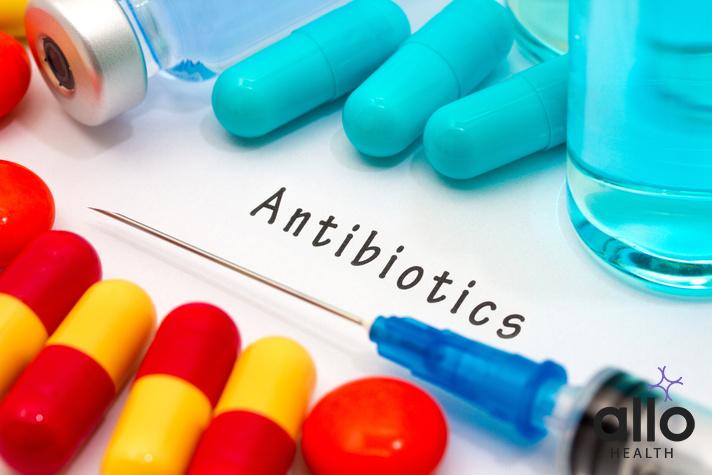What Are The Symptoms And Complications Of Gonorrhea?

Allo Health is dedicated to personalized well-being, offering support and trusted information tailored to individual health goals. The platform emphasizes human-generated content, led by a distinguished medical team of experts, including physicians and sexual health specialists. Their commitment to credibility involves rigorous fact-checking, authoritative research, and continuous updates to ensure accurate, up-to-date information. Allo Health's unique approach goes beyond conventional platforms, providing expert-led insights and a continuous commitment to excellence, with user feedback playing a crucial role in shaping the platform's authoritative voice.

Dr. Aditi completed her undergraduate medical education at AJIMS, Mangalore, after which she worked in multi-speciality hospitals with COVID patients and in the Pain and Palliative medicine department. Driven by her experiences, she developed a keen interest in psychiatry. Dr. Aditi believes that mental health is just as, if not more important, than physical health.
Why This Was Upated?
Our experts continually monitor the health and wellness space, and we update our articles when new information became available.
Updated on 29 April, 2024
- Article was updated as part of our commitment to diversity, equity, and inclusion.
"The following blog article provides general information and insights on various topics. However, it is important to note that the information presented is not intended as professional advice in any specific field or area. The content of this blog is for general educational and informational purposes only.
Book consultation
The content should not be interpreted as endorsement, recommendation, or guarantee of any product, service, or information mentioned. Readers are solely responsible for the decisions and actions they take based on the information provided in this blog. It is essential to exercise individual judgment, critical thinking, and personal responsibility when applying or implementing any information or suggestions discussed in the blog."
Gonorrhea, often dubbed “the clap” or “the drip,” is a prevalent sexually transmitted infection caused by the bacterium Neisseria gonorrhoeae. Despite its prevalence, many individuals remain unaware of the symptoms and potential complications associated with gonorrhea. In this comprehensive guide, we will delve into the intricate details of gonorrhea symptoms, ranging from the common to the less recognized, and explore the potential complications that can arise if the infection is left untreated.
Understanding Gonorrhea Symptoms
What Are The Symptoms And Complications Of Gonorrhea? Gonorrhea symptoms can vary widely between individuals and may differ based on factors such as gender, site of infection, and the presence of concurrent infections. While some individuals may experience noticeable symptoms, others may remain asymptomatic carriers, unknowingly spreading the infection to sexual partners.
Genital Symptoms
- Painful Urination: A hallmark symptom of gonorrhea, painful urination, results from inflammation of the urethra or other genital structures. The sensation may range from a mild discomfort to a sharp, burning pain during urination, prompting individuals to seek medical evaluation.
- Abnormal Discharge: Men with gonorrhea may notice a thick, yellowish or greenish discharge from the penis, while women may experience increased vaginal discharge that is discolored or malodorous. The presence of abnormal discharge often indicates an active infection and may prompt individuals to seek testing and treatment.
- Genital Itching or Irritation: In some cases, individuals with gonorrhea may experience itching or irritation in the genital area, accompanied by redness or swelling. These symptoms can be distressing and may interfere with daily activities, prompting individuals to seek relief through medical intervention.
Rectal Symptoms
- Anal Itching or Discomfort: Gonorrhea can infect the rectum, leading to symptoms such as anal itching, discomfort, or pain during bowel movements. These symptoms may mimic those of other conditions such as hemorrhoids or anal fissures, highlighting the importance of thorough evaluation and testing.
- Rectal Discharge: Infected individuals may notice abnormal discharge from the rectum, which may be accompanied by blood or mucus. Rectal discharge may vary in consistency and color, ranging from watery to thick, and may be present intermittently or persistently.
Throat Symptoms
- Sore Throat: Gonorrhea can be transmitted through oral-genital contact, leading to symptoms such as a sore throat, swollen tonsils, or difficulty swallowing. Throat symptoms may develop within days to weeks after exposure and may be mistaken for other respiratory infections in the absence of genital symptoms.
- Hoarseness or Voice Changes: In some cases, gonorrhea infection of the throat may cause hoarseness or changes in voice quality. These symptoms may be subtle and may not initially prompt individuals to seek medical evaluation, delaying diagnosis and treatment.
Eye Symptoms
- Conjunctivitis: Neonatal conjunctivitis can occur in infants born to mothers with untreated gonorrhea, leading to symptoms such as redness, swelling, and discharge from the eyes. Prompt recognition and treatment of neonatal conjunctivitis are essential for preventing long-term complications such as corneal scarring and vision impairment.
- Eye Pain or Sensitivity to Light: In rare cases, gonorrhea can cause severe eye infections in adults, resulting in symptoms such as eye pain, sensitivity to light (photophobia), and blurred vision. These symptoms may indicate a serious ocular infection requiring immediate medical attention to prevent vision loss.

Complications of Gonorrhea
Untreated gonorrhea can lead to a myriad of complications, ranging from localized infections to systemic dissemination. It’s crucial to recognize these potential complications and seek timely medical intervention to prevent long-term sequelae.
Pelvic Inflammatory Disease (PID)
- Chronic Pelvic Pain: PID can cause chronic pelvic pain, which may persist even after successful treatment of the acute infection. Chronic pelvic pain can significantly impact quality of life and may require multidisciplinary management approaches to address physical and psychosocial factors contributing to pain.
- Infertility: Untreated PID can lead to scarring and damage to the reproductive organs, increasing the risk of infertility. In women, tubal scarring may obstruct the fallopian tubes, preventing the passage of eggs from the ovaries to the uterus and impairing fertility.
- Ectopic Pregnancy: Scarring and inflammation resulting from PID can increase the risk of ectopic pregnancy—a potentially life-threatening condition where a fertilized egg implants outside the uterus, typically in the fallopian tubes. Ectopic pregnancy requires prompt medical intervention to prevent rupture and hemorrhage.
Epididymitis
- Testicular Pain and Swelling: Epididymitis can cause severe testicular pain and swelling, often localized to one side. The affected testicle may feel tender to the touch, and the scrotum may appear red, warm, or swollen.
- Abscess Formation: In severe cases, untreated epididymitis can lead to abscess formation within the epididymis or surrounding tissues. Abscesses may present as palpable masses within the scrotum and may require drainage or surgical intervention to prevent complications such as tissue necrosis or sepsis.
Disseminated Gonococcal Infection (DGI)
- Fever and Chills: DGI is characterized by systemic symptoms such as fever, chills, and malaise, indicating the dissemination of Neisseria gonorrhoeae through the bloodstream. Fever may be low-grade or high-grade and may fluctuate in intensity over time.
- Joint Pain (Arthritis): DGI can cause migratory joint pain and swelling, often affecting large joints such as the knees, ankles, wrists, and elbows. Joint pain may be accompanied by stiffness, redness, and decreased range of motion, impairing mobility and quality of life.
- Skin Rash: A characteristic skin rash may develop in individuals with DGI, typically presenting as small, red or purple lesions on the extremities and trunk. The rash may be maculopapular or petechial in nature and may be accompanied by itching or discomfort.
Gonorrhea is a complex sexually transmitted infection with a wide spectrum of symptoms and potential complications. Recognizing the signs and seeking timely medical care are essential for preventing long-term sequelae and reducing the transmission of gonorrhea within communities. By raising awareness of gonorrhea symptoms and complications, we can empower individuals to prioritize their sexual health and seek appropriate testing and treatment when needed. Remember, early detection and intervention are key to mitigating the impact of gonorrhea on individuals and public health as a whole.

Most Asked Questions
-
What are the current treatment options for gonorrhea?
Currently, the recommended treatment for gonorrhea involves a single intramuscular injection of ceftriaxone, often combined with an oral dose of azithromycin. This dual therapy helps to ensure effective treatment and reduce the risk of developing antibiotic resistance. Alternative antibiotics may be considered based on individual factors such as allergies or treatment failure.
-
How effective are these treatments against gonorrhea?
Ceftriaxone and azithromycin have demonstrated high efficacy in treating gonorrhea, with cure rates exceeding 95%. However, increasing rates of antibiotic resistance pose challenges to their effectiveness. Close monitoring of treatment outcomes and resistance patterns is essential to ensure continued effectiveness.
-
What are the complications associated with untreated gonorrhea?
Untreated gonorrhea can lead to severe complications such as pelvic inflammatory disease (PID), which can result in chronic pelvic pain and infertility. In men, untreated gonorrhea can cause epididymitis, leading to potential fertility issues. Additionally, untreated gonorrhea increases the risk of transmitting the infection to sexual partners.
-
How can antibiotic resistance in gonorrhea be addressed?
Addressing antibiotic resistance requires a multifaceted approach. This includes promoting judicious antibiotic use, enhancing surveillance of resistant strains, and investing in research to develop new antibiotics or alternative treatment strategies. Antimicrobial stewardship programs can also help optimize antibiotic use and minimize the development of resistance.
-
What preventive measures can be taken to reduce the spread of gonorrhea?
Preventive measures include practicing safe sex by using condoms consistently and correctly, reducing the number of sexual partners, and getting tested regularly for sexually transmitted infections, including gonorrhea. Partner notification and treatment are also crucial to prevent reinfection and further transmission within communities.









































